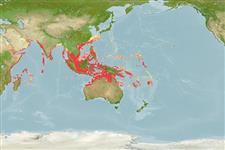Classification / Names
Common names from other countries
Main reference
Size / Weight / Age
Max length : 40.0 cm TL male/unsexed; (Ref. 2872); common length : 30.0 cm TL male/unsexed; (Ref. 2872)
Length at first maturity
Lm 16.8 range ? - 19.2 cm
Environment
Marine; brackish; pelagic-neritic; depth range 15 - 100 m (Ref. 30573)
Climate / Range
Tropical, preferred 28°C (Ref. 107945); 30°N - 21°S, 36°E - 178°W
Distribution
Short description
Dorsal
spines
(total): 8 - 9;
Dorsal
soft rays
(total): 20-22;
Anal
spines: 3;
Anal
soft rays: 25 - 28. Silvery grey with blue iridescence dorsally, silvery white ventrally; upper part of gill cover with a dusky black spot; fins pale yellow. Mouth large and oblique.
IUCN Red List Status (Ref. 115185)
Threat to humans
Harmless
Human uses
Fisheries: commercial
More information
ReferencesAquacultureAquaculture profileStrainsGeneticsAllele frequenciesHeritabilityDiseasesProcessingMass conversion
Tools
Special reports
Download XML
Internet sources
Estimates of some properties based on models
Phylogenetic diversity index
PD50 = 1.5000 many relatives (e.g. carps) 0.5 - 2.0 few relatives (e.g. lungfishes)
Trophic Level
4.2 ±0.7 se; Based on diet studies.
Resilience
High, minimum population doubling time less than 15 months (K=0.6)
Vulnerability
Low vulnerability (21 of 100)
Price category
